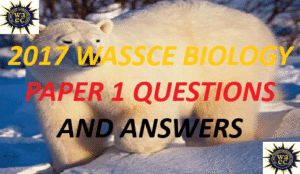Morphology of Angiosperms (flowering plants)

Morphology of Angiosperms (flowering plants)
Briefly describe the functions of a land plant’s root and shoot systems.
Shoot system:
- A land plant’s shoot system consists of its photosynthetic tissues and organs, stems, leaves, and buds.
- Stems are frameworks for upright growth and favorably position leaves for light exposure and flowers for pollination.
- Leaves increase a plant’s surface area and thus its exposure to sunlight.
- Buds eventually extend the shoot or give rise to a new, branching shoot.
- The shoot system of a flowering plant also includes flowers and fruits.
- Parts of the shoot system store carbohydrates manufactured during photosynthesis.
Root system:
- The root system usually grows below ground.
- It anchors the plant, and sometimes structurally supports its upright parts.
- It also absorbs water and dissolved minerals from soil and stores carbohydrates.
List the three vegetative organs in a plant and state their major functions.
Vegetative organs are:
- The leaves for photosynthesis.
- The stem for support, new growth, and transport.
- The root absorbs water and minerals.
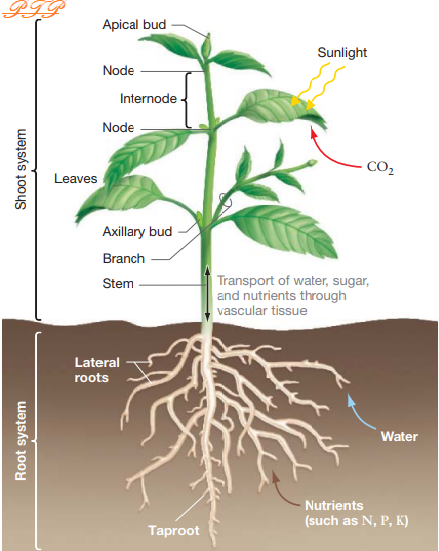
Explain what meristem tissue is, and describe the roles of meristems in forming the plant body.
- Meristem tissue is self-perpetuating embryonic tissue.
- Apical meristems, at the tips of shoots and roots, gives rise to a young plant’s stems, buds, roots, and other primary tissues.
- In plants that show secondary growth, cylinders of lateral meristem tissue give rise to (often woody) secondary tissues that increase the diameter of older stems and roots.
List the three specialized tissues in a plant and the cells that make up these tissues.
- Epidermal tissue: epidermal cells
- Ground tissue: parenchyma, collenchyma, and sclerenchyma cells.
- Vascular tissue: xylem (vessel elements and tracheid) and phloem (sieve-tube members)
Describe the defining features, cellular components, and functions of the ground tissue system.
- The ground tissue system makes up most of the plant body.
- It includes three types of structurally simple tissues parenchyma, collenchyma, and sclerenchyma each of which is composed mainly of one type of cell.
- Parenchyma makes up most of a plant’s primary tissue and typically has air spaces between its cells, which are alive at maturity and can continue to divide.
- Subgroups of parenchyma cells are specialized for photosynthesis, secretion, and storage (of starch).
- Collenchyma is flexible ground tissue that contains cellulose.
- Its cells remain alive and metabolically active at maturity.
- They provide mechanical support for parenchyma and often collectively form strands or a sheath-like cylinder under the dermal tissue of growing shoot regions and leaf stalks.
- Cells of sclerenchyma are dead at maturity, but they develop thick secondary walls while alive that typically are lignified and provide additional support and protection in mature plant parts.
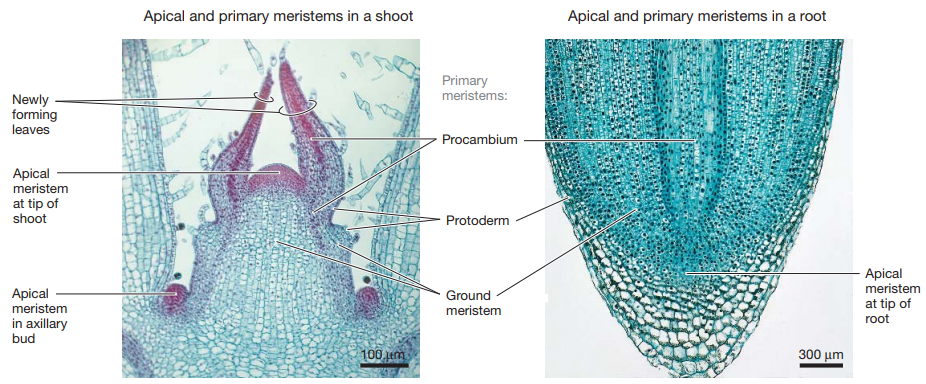
Describe the relationship between the root apical meristem and the root cap.
- The root apical meristem is located at the tip of the root and is covered by the root cap.
What are the functions of the vascular tissues xylem and phloem?
- Xylem and phloem are the tissues of the vascular tissue system.
- The two types of xylem cells, tracheid, and vessel members develop thick, lignified secondary cell walls and die at maturity.
- The empty cell walls of abutting cells serve as pipelines for water and minerals.
- The conducting cells of phloem, called sieve tube members, form sieve tubes that conduct solutes, mainly sugars made during photosynthesis, throughout a plant.
Compare the transport function of the xylem and phloem.
- Xylem transports water and minerals usually from roots to leaves.
- Phloem transports organic compounds throughout the plant.
What are the cellular components and functions of the dermal tissue system?
- The dermal tissue system serves as a skin-like protective covering for the plant body.
- Cells of the epidermis are tightly packed and cover the primary plant body.
- They secrete a cuticle that coats all plant parts except the very tips of the shoot and most absorptive parts of roots.
- Some epidermal cells become modified for specialized functions.
- Examples include guard cells, which form stomata; root hairs, which absorb water and minerals; and hairlike trichomes, which function in defense against herbivory or secrete sugars that attract pollinators.
Describe the zones of primary growth in roots.
- The root apical meristem and the actively dividing cells behind it form the zone of cell division.
- Cells in the center of the root tip become the procambium; those just outside the procambium become ground meristem; and those on the periphery of the apical meristem become protoderm.
- The zone of cell division merges into the zone of elongation, where most of the increase in a root’s length occurs.
- Above the zone of elongation, cells may differentiate further and take on specialized roles in the zone of maturation.
Describe the various tissues that arise in a root system and their functions.
- Primary root growth produces a system of vascular pipelines extending from root tip to shoot tip.
- The root procambium produces cells that mature into the root’s xylem and phloem.
- Ground meristem gives rise to the root’s cortex, its ground tissue of starch-storing parenchyma cells that surround the stele.
- In many flowering plants, the outer root cortex cells give rise to an exodermis, a thin band of cells that may limit water losses from roots and help regulate the absorption of ions.
- The innermost layer of the root cortex is the thin endodermis, which helps control the movement of water and dissolved minerals into the stele.
- Between the stele and the endodermis is the pericycle, which gives rise to lateral roots.
- In some cells in the developing root epidermis, the outer surface extends into root hairs.
List the function of the cortex, the endodermis, and the pericycle in a root.
- Cortex: stores
- Endodermis: regulates mineral uptake.
- Pericycle: formation of lateral roots.
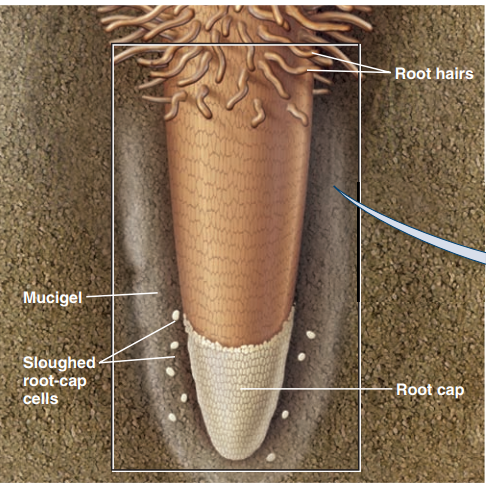
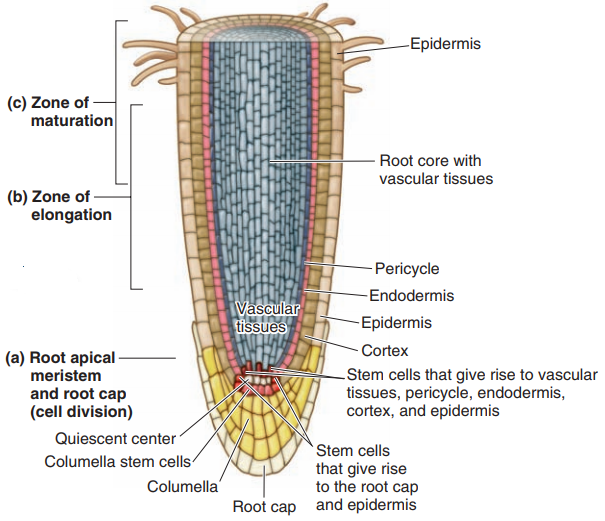
State the functions of stems and stem structure.
Stems have five main functions:
- Stems provide mechanical support for body parts involved in growth, photosynthesis, and reproduction
- They house the vascular tissues (xylem and phloem), which transport products of photosynthesis, water and dissolved minerals, hormones, and other substances throughout the plant.
- Stem may often be modified to store water and food.
- They have specific stem regions that contain meristematic tissue, which gives rise to new cells of the shoot.
- Stems also hold leaves and flowers in position for photosynthesis and pollination.
List the basic steps in the primary growth of stems.
- A plant stem is divided into modules, each consisting of a node, where leaves are attached, and an internode, the space between nodes.
- New primary growth occurs in buds.
- A terminal bud at the apex of the main shoot, and lateral buds, which produce branches (lateral shoots), in the leaf axils.
- Meristem tissue in buds gives rise to leaves, flowers, or both.
- In dicots, most primary growth in a stem’s length occurs directly below the shoot apical meristem.
- When a meristematic cell divides, one of its daughter cells becomes an initial, a cell that remains as part of the meristem.
- The other daughter cell becomes a derivative, which typically divides once or twice and then enters the path to differentiation.
- As derivatives differentiate, they give rise to three primary meristems: protoderm, procambium, and ground meristem.
- These primary meristems produce cells that differentiate into specialized cells and tissues.
- The primary meristems are also responsible for the elongation of the plant body.
- Each primary meristem occupies a different position in the shoot tip.
- Outermost is the protoderm, which gives rise to the stem’s epidermis.
- Inward from the protoderm, the ground meristem gives rise to ground tissue (mostly parenchyma).
- Procambium, which produces the primary vascular tissues, is sandwiched between ground meristem layers.
- In most plants also, inner procambial cells give rise to the xylem and outer procambial cells to the phloem.
- The developing vascular tissues become organized into vascular bundles that are wrapped in sclerenchyma and thread lengthwise through the parenchyma.
- In the stems and roots of most eudicots and some conifers, the vascular bundles form a stele (vascular cylinder) that vertically divides the column of ground tissue into an outer cortex and an inner pith.
Explain the general function of leaves and how leaf anatomy supports this role in dicots and monocots.
- Leaves are organs specialized for photosynthesis.
- In both dicots and monocots, the leaf blade provides a large surface area for absorbing sunlight and carbon dioxide.
- Many dicot leaves have a broad, flat blade attached to the stem by a petiole.
- Unless a petiole is very short, it holds a leaf away from the stem and helps prevent individual leaves from shading one another.
- In most monocot leaves, such as those of rye grass or corn, the blade is longer and narrower and its base simply forms a sheath around the stem.
What transport tissues are in a vascular bundle?
- Xylem
- Phloem
How are vascular bundles arranged in monocot stems? In eudicot stems?
- Vascular bundles are scattered in monocot stems
- Vascular bundles form a ring in eudicot stems
Differentiate between primary growth with secondary growth.
- Primary growth is growth in length and is nonwoody while secondary growth is growth in girth and is woody.
State the components of bark.
The bark is composed of;
- cork,
- cork cambium,
- cortex,
- phloem
Describe the steps in the primary growth of a leaf and the structures that result from the process.
- Leaves develop on the sides of the shoot apical meristem. Initially, meristem cells near the apex divide, and their derivatives elongate.
- The resulting bulge enlarges into a thin, rudimentary leaf, or leaf primordium.
- As the plant grows and internodes elongate, the leaves become spaced at intervals along the length of the stem or its branches.
- Leaf tissues typically form several layers.
- Uppermost is the epidermis, with a cuticle covering its outer surface.
- Just beneath the epidermis is mesophyll, which is composed of loosely packed parenchyma cells that contain chloroplasts.
- Leaves of many plants, especially eudicots, contain two layers of mesophyll.
- Palisade mesophyll cells contain more chloroplasts and are arranged in compact columns with smaller air spaces between them, typically toward the upper leaf surface.
- Spongy mesophyll, which tends to be located toward the underside of a leaf, consists of irregularly arranged cells with a network of air spaces that enhance the uptake of carbon dioxide and release of oxygen during photosynthesis and account for 15% to 50% of a leaf’s volume.
- Below the mesophyll is another cuticle-covered epidermal layer.
- Except in grasses and a few other plants, this layer contains most of the stomata through which water vapor exits the leaf and gas exchange occurs.
- Vascular bundles form a network of veins throughout the leaf.
Describe two examples of the life phases of long-lived plant species.
- Plants that live for many years may spend part of their lives in a juvenile phase, and then shift to a mature, or adult phase.
- The differences between juveniles and adults often are reflected in leaf size and shape, the arrangement of leaves on the stem, or a change from vegetative growth to a reproductive stage.
- Most woody plants must attain a certain size before their meristem tissue can respond to the hormonal signals that govern flower development.
Briefly explain how secondary growth occurs in plants.
- Secondary growth processes add girth to roots and stems over two or more growing seasons.
- In plant species that have secondary growth, older stems and roots become more massive and woodier through the activity of two types of lateral meristems.
- One of these meristems, the vascular cambium, produces secondary xylem and phloem.
- The other, the cork cambium, produces cork, a secondary epidermis that is one element of bark.

Describe the components of the vascular cambium and their roles in secondary growth in stems, including the development of tissues such as bark, cork, and wood.
- Vascular cambium consists of two types of cells fusiform initials and ray initials.
- Fusiform initials are derived from cambium inside the vascular bundles, giving rise to secondary xylem and phloem cells.
- Secondary xylem forms on the inner face of the vascular cambium, and secondary phloem forms on the outer face.
- Ray initials are derived from the parenchyma cells between vascular bundles.
- Their descendants form spoke-like rays of parenchyma cells which are horizontal channels that carry water sideways through the stem.
- As the mass of the secondary xylem inside the ring of vascular cambium increases, it forms hard tissue known as wood.
- Bark encompasses all of the living and non-living tissues between the vascular cambium and the stem surface.
- It includes the secondary phloem and the periderm, the outermost portion of bark that consists of cork, cork cambium, and secondary cortex.
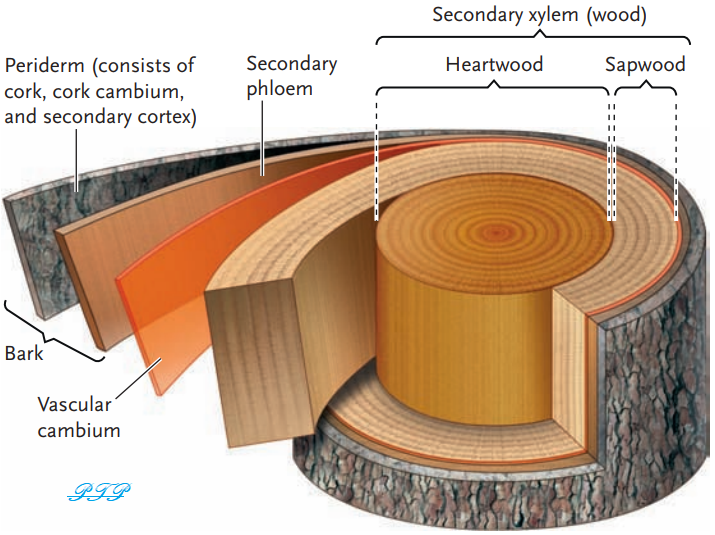
Structure of a woody stem showing extensive secondary growth.
What is the importance of the mesophyll to a plant?
- Photosynthesis, which produces organic food for a plant, occurs in the mesophyll.
Join Enlighten Knowledge WhatsApp Channel.
Join Enlighten Knowledge Telegram platform.





